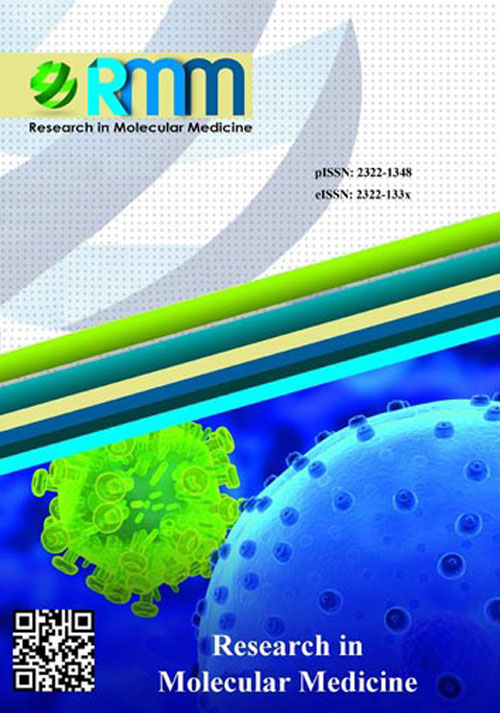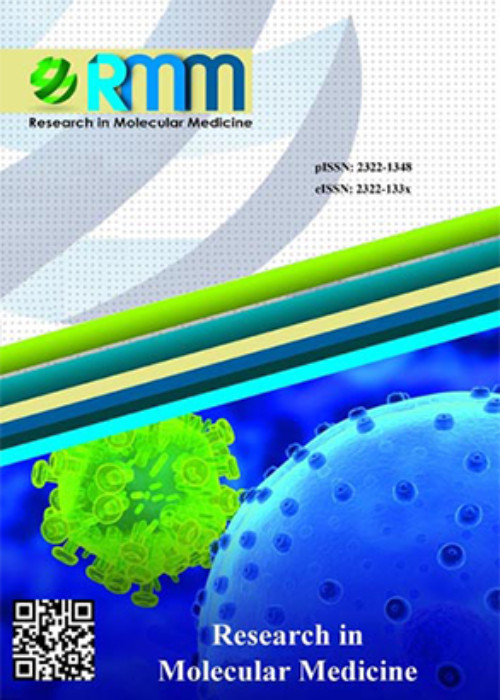فهرست مطالب

Research in Molecular Medicine
Volume:5 Issue: 1, Feb 2017
- تاریخ انتشار: 1396/03/09
- تعداد عناوین: 7
-
-
Page 1BackgroundHepatitis C virus (HCV) causes acute and chronic human hepatitis infections. Due to the high genetic diversity and high rates of mutations in the genetic material so far there is no approved vaccine against HCV.Materials And MethodsThe aim of this study was to determination B and T cell conserved epitopes of E1 and E2 proteins from HCV and construction of a chimeric peptide as a novel epitope based vaccine for cross-protection against the virus. For this, one B and T-cell epitope from both E1 and E2 which was predicted by EPMLR and Propred-1 server and had the highest score and antigenicity in VaxiJen 2.0 and PAP servers were selected for construction of chimeric protein as a multi-epitope vaccine.ResultsThe results of this study showed that the chimeric peptide had high antigenicity score and stability.Results also showed that most epitopes of E1 were located in two spectra consist of (45-65,88-107 and 148-182) while the results about B-cell epitopes of E2 showed that this protein had much less epitope than E1. The most epitope predicted for E2 were located in (12-24 and 35-54) spectraConclusionIn conclusion, epitope based vaccine which was designed by immunoinformatics methods could be considered as a novel and effective vaccine for cross-protection against HCV infection.Keywords: Hepatitis C virus_Immunoinformatics_Epitope prediction
-
Page 2Alpha Thalassemia is one of the most prevalent disorders worldwide with a [T1] high carrier rate in Mazandaran province (north of Iran). Carriers of --MED double gene deletion are at risk of having a child with hemoglobin haemoglobin[T2] H (HbH) disease, if they marry a silent carrier. Co-inheritance of αααAnti3.7 triplication that cannot be detected using hematological indices and β-globin gene mutations, in heterozygote states, leads to intermediate form of thalassemia. Using precise molecular analysis, the mutations that do not change the hematological parameters can be identified. The diagnosis of these mutations is important in screening programs. Multiplex Gap-PCR and reverse hybridization assay analysis were applied for the detection of mutations on α and β-globin genes in a patient with abnormal hematological[T3] indices from Sari at 2016. A rare co-inheritance of --MED double gene deletion and αααAnti3.7 triplication was identified. The presented case can be at risk of having a child with HbH disease and thalassemia intermedia. So, the presented case shows the [T4] importance of precise molecular analysis in premarital screening in order to prevent having a child with thalassemia.Keywords: Alpha Thalassemia, αααanti3.7 triplication, --MED double gene deletion
-
Page 3BackgroundVitrification of oocytes is a fast-freezing technique, which may affect the quality of the human oocyte, and consequently affects the embryo development, pregnancy and birth. The aim of the current study was to investigate the consequence of in-vitro vitrification on maturation status of immature human oocytes, additionally, expression levels of stress, and apoptosis related genes.Materials And MethodsThe total of 213 human immature oocytes which routinely discarded from assisted reproduction clinics were collected and divided into two groups including: (I) fresh germinal vesicle (GV) oocytes (n=106) (matured in-vitro (fIVM) , and (II) GV oocytes (n=107) that initially vitrified, then matured in in-vitro (vIVM). After 36 hours of incubation, the oocytes were evaluated for nuclear maturation and expression level of DNA methyltransferase (DNMT1), stress related genes (Sod1 and Hsp70), and apoptotic related genes (Bax and Bcl-2) by quantitative Real-Time PCR.ResultsOocyte maturation rates were reduced in vIVM compared to fIVM oocytes (P=0.001). The expression of stress (Sod1 and Hsp70), and apoptotic-related genes (Bax and Bcl-2) in vIVM were significantly higher compared to the fIVM group. Additionally, pro-apoptotic gene up-regulated 4.3 times more than anti-apoptotic gene in vIVM oocyte. However, DNMT1 gene expression was reduced in vIVM oocyte (P = 0.047).ConclusionsThe low survival rate of vitrified In-vitro matured GV oocytes could definitely be explained by the alterations of their gene expression profile.Keywords: Apoptosis, Oocytes, Vitrification
-
Page 4Recent disgracing reports are warning the scientific communities to think more about the solutions to win the battle against predatory journals and publishers. Current integrity and accuracy in science is a result of decades of honest works and publications which are an asset, now everyone as stakeholders of science should feel the responsibility to sustain its high privileged level. The ethical sides of this duty need careful considerations by science stakeholders worldwide. Boosting the weak resume, getting higher and faster promotion and permanent jobs in academia cannot figure out as reasonable excuses to publish unethically. Hereby, I suggest a practical roadmap based on certain strategies which are recommendable for the scientific community. This paper describes authors perspective about predatory journals and how we can stop them. Moreover, following the appearance of the predatory journal, this is a first article discussing root cause analysis on this global scientific problem. Last but not least, predatory journals are not too bad! Since they can be considered as a critical discriminatory tool to distinguish between individuals who work truly standard and who pretend to work standard.Keywords: Predatory Publishing, scientific misconduct, peer-review, Open Access, Scientific reputation, Education, Policy
-
Page 5Although standard treatments are nearly life-saving in hepatitis C patients, all patients equally dont respond to such medications. To achieve a favorable therapeutic response in all patients, medications might alter between individuals based on genetic factor variations. Hence, having a detailed knowledge of the affecting factors on the disease promotion could help us to organize an appropriate regime to treat the HCV patients. The data was collected from the clinical and molecular studies published during the last 15 years that elicited from electronic databases such as Pubmed, Google scholar, Medline, Scopus and web of sciences. The literature reviews the recent clinical studies with the genetic-based aspects, especially those factors affecting on the etiopathological and histological feature of hepatitis C, diagnostic, genetic and viral affecting criteria as well as some effective treatment strategies.Keywords: Hepatitis C virus_Genetic Host Factors_Sustained Virologic Response
-
Prompt cytomolecular identification of chromosome aberration in irradiated blood cellsPage 6Backgroundunderstanding the genomic alteration induced by ionizing radiation still remains to be a methodological challenge in genetic field. The energy released from this type of radiation can potentially causes structural and numerical alterations in lymphocytes, which in turn converts them into abnormal tumor cells. Chromosomal abnormalities associated with specific type of hematological malignancies are determinant factors in evaluation of radiation dose and its potential in harming the body. None the less early detection of chromosomal aberration (CA) is crucial in prognosis and selection of therapy for the people exposed to irradiations. The aim of this study was to explore a swift and accurate genetic test that identifies CAs in radiologist exposed to X-rays. In addition synergistic effect of other clastogens in irradiated workers was also evaluated.
Material andMethodsthirty four heparinized blood samples were obtained from radiology workers exposed to X-rays. Blood samples were cultured in RPMI 1640 and F-10 Medias with and without PHA stimulation. Lymphocytes were harvested, separated and arrested at metaphase and their chromosomes were analyzed by solid and G-Banding techniques. Lymphocytic CA was also analyzed through whole chromosome painting FISH.Resultsof the 37 blood sample from workers, 60% had various structural aberrations in which both the frequency and type of CAs were intensified among tobacco smokers.Conclusionthe results did not show any significant differences between the genders but other carcinogen like smoking can significantly increases the rate of CAsKeywords: Chromosome aberration, X-ray radiation, G-banding, Painting FISH -
Detection of Intracellular Adhesion (ica) and Biofilm Formation Genes in Staphylococcus aureus Isolates from Clinical SamplesPage 7IntroductionNosocomial infections that result in the formation of biofilms on the surfaces of biomedical implants are a leading cause of sepsis and are often associated with colonization of the implants by Staphylococcus epidermidis. Biofilm formation is thought to require two sequential steps: adhesion of cells to a solid substrate followed by cell-cell adhesion, creating multiple layers of cells. Intercellular adhesion requires the polysaccharide intercellular adhesion (PIA), which is composed of linear β-1, 6-linked glucosaminylglycans and can be synthesized in vitro from UDP-N-acetylglucosamine by products of the intercellular adhesion (ica) locus. We have investigated a variety of Staphylococcus aureus strains and find that all strains tested contain the ica locus and that several can form biofilms in vitro.
Material andMethodA total of 31 clinical S. aureus isolates were collected from Zabol, Iran. In vitro biofilm formation ability was determined by microliter tissue culture plates. All clinical isolates were examined for determination the ica locus by using PCR method.ResultThe results of this study showed that 40 strains of Staphylococcus aureus, 12 strains carrying the gene Cocos icaA (30%) and 8 strains carrying the gene icaD (20%) and the number of five strains (12.5%) containing both genes ica A and has been ica D.ConclusionsS. aureus clinical isolates have different ability to form biofilm. This may be caused by the differences in the expression of biofilm related genes, genetic make-up and physiological conditions.Keywords: Biofilm, Staphylococcus aureus, Gene, Pathogenic


